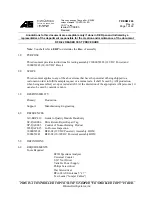
Functions
R&S
®
OSP
208
User Manual 1178.7100.02 ─ 05
Select a path in each path selection box. Note that changing the "Address Count"
resets all path selection boxes.
Activation:
When you activate the trigger, the next incoming
valid and stable trigger event
switches the
addressed
path, as described in the following:
●
Address
: the trigger control system reads the states of the lines 1 to 4 of the D-
Sub
9 connector (and ignores the lines 5 to 9). It interprets the 4-digit binary states
as the address value for the address to be triggered.
Example
: If pins 1 and 3 are in high state and pins 2 and 4 are in low state, the
binary readout is 0101 (most significant bit first). The decimal equivalent of 0101 is
the address 5. Hence, the control system triggers the 5
th
path, which is "Path 04"
(starting with "Path 00" as the 1
st
path).
●
Trigger event
: a change on any of the 4 lines is interpreted as a trigger event.
Hence, the addressed path remains switched, until the address code changes.
This rule is true also for the 1
st
path ("Path 00"). Consider an arbitrary address that
differs from
0000
: If in this address, the non-zero lines return to the low state, this
binary
0000
is interpreted as a new trigger event that switches "Path 00".
●
Validity
: a trigger event is valid, if the encoded address exists. For example, if you
have set the "Address Count" to 7, all received addresses from 8 to 16 establish an
invalid trigger event, which is ignored.
●
Stability
: for a trigger event to be stable, the following requirements must all be
met:
–
Each change of an address value must happen within 15
ns.
Address values that do not remain stable for at least 15
ns are interpreted as a
glitch or spike and are ignored.
–
Each address must remain unchanged for at least the duration of the minimum
trigger interval (typically 2
µs). If the address changes sooner, the control sys-
tem can process or ignore the change, depending on several parameters.
Hence, a premature change can lead to an undefined switching state.
Remote command:
Trigger Settings
The "Trigger Settings" section (lower portion of
) is accessible only, if the
trigger is
. It provides the following:
●
The "Trigger Level" is valid for the front trigger connectors (BNC), only. It is the sig-
nal level, at which the switch unit's control system interprets a voltage change as a
trigger event. The "Trigger Level" is compatible with values between 0.5
V and
4.5
V.
The "Trigger Level" setting is not available, if the "Trigger Type" is
.
●
The "Trigger Slope" is valid for the front trigger connectors (BNC), only. It can be
"Positive", "Negative" or "Any".
–
If you select "Positive", a transition of the "Trigger Level" from a lower voltage
to a higher voltage is interpreted as a trigger event.
–
On the contrary, if you select "Negative", a transition of the "Trigger Level" from
a higher voltage to a lower voltage is interpreted as a trigger event.
–
If you select "Any", both a positive and a negative transition are valid trigger
events.
Configuration
















































